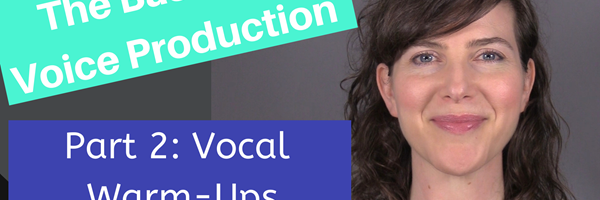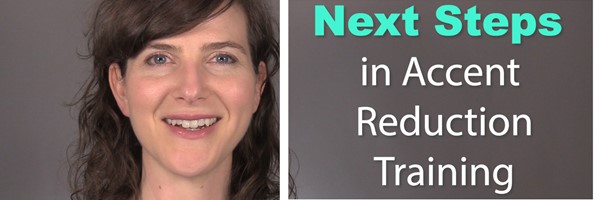*** Warning: This video shows clips of actual vocal cords within the throat and other anatomical drawings of the face, head, and neck. These may be unsettling for some viewers***
(Video Transcript)
Introduction to the Voice Series
This video is part of a series that focuses on the voice. Voice refers to the way a person sounds when they speak. It’s not the words that a person uses, but how they say them.
Many of my clients want to speak with a confident-sounding voice, or speak with more authority. Those are maybe some positive adjectives to describe a desirable voice. And what about some negative adjectives - creaky, rough, speaking with a fry voice. I think we all agree that confidence and authority are more desirable than rough and fry. But how do you achieve a confident and authoritative voice? How can you change your voice to sound that way?
I created this voice series to teach my clients how they make their voices and then how to change them to sound better, more professional, more exciting. This first video will give you the background on how our voices are made in the body. It’s a bit technical, but it’s worth it to learn about the different systems in the body that control the voice. Once you understand how our voices are made, it will make much more sense when you start to exercise the voice - you’ll know what to do, how to do it, and why you’re doing it.
Basics of Voice Production Part 1: The Voicing Subsystems
The voice is a delicate yet complex system that is capable of producing a wide range of sounds, emotions, and hidden undertones that add meaning to what we say. For the most part, our voices work automatically - we have a thought about what we want to say, and then we say it. And because most of the inner workings of the voice are internal - we can’t see the voice when we use it - that makes it difficult to fully understand how the voice happens. Today I’ll try to explain this process with an introduction to how we produce our voice and the body systems that are involved in the process.
There are four main body systems involved in producing voice and speech:
The first system is the respiratory system. The respiratory system provides the voice with its power source - the breath. It includes the lungs, rib cage, diaphragm, and other muscles that are responsible for opening up the lungs to allow air to flow in, and then contracting the lungs so that air can flow out.
The second system is the phonatory system. The phonatory system provides the voice with its sound source - the vocal cords. The vocal cords are located just behind the Adam’s apple. The vocal cords are small pieces of tissue that are shaped in a V configuration - they are attached at the front and open in the back. The movement of the vocal cords is controlled by muscles within the inner throat. When we breathe, the vocal cords are open to allow air to flow down into the lungs and out again without any obstruction. When we speak, the vocal cords come together. Air from the lungs is pushed up through the vocal cords, which causes them to vibrate. This vibration is called “voicing” or “phonation”. The vocal cords are also responsible for changing the pitch of the voice. When they are stretched out, similar to a rubber band when it is pulled, the pitch of the voice is high. When the vocal cords relax and shorten, the pitch of the voice is low. But this sound is not yet considered to be our unique voice. That happens in the next system.
The third system is the resonatory system. The resonatory system provides the voice with its distinct quality, and it is why we all sound different from each other. The resonatory system is made up of the open spaces within the throat, mouth, and nose, so you can think of the resonatory system as an open space. The sound that is made at the level of the vocal cords is only a buzzing sound, and we all sound very similar to each other at this level. However, as that buzzing sound travels up through the resonatory system, it bounces from one surface to the next. Certain frequencies are enhanced, and other frequencies are dampened, and the end result is our unique-sounding voice. If you open your mouth and say “ahh!”, you will hear an example of your unique voice - a pure vowel tone.
The fourth system is the articulatory system. The articulatory system uses the lips, tongue, teeth, and jaw to shape the voice into speech. For example, if I open my mouth and say “ahh”, I will hear a pure vowel tone. But when I bring my lips together and quickly pull them apart, I have now shaped that pure vowel tone into a speech sound - the P sound, like in please.
How do these systems work together when we speak?
These systems are powered by lots of muscles, cartilages, and bones that work together like a well-oiled machine to produce intelligible speech and voice. I’m going to demonstrate how each system works together when we speak.
I start by taking a deep breath using the respiratory system. Then as I exhale, or push the air out, my vocal cords close together and a sound is produced, called phonation or voicing. That sound travels through my resonatory system, the open spaces within my throat, mouth, and nose, and then you hear my unique-sounding voice saying “ahhh”. I’ll use the phonatory system to change the pitch of my voice, from low to high to low.
Now I’ll use the articulatory system to shape my voice into speech. “Hello, my name is Julie. How are you doing today?”
Each system of the voice is equally important to producing a strong voice and clear speech, and they each require exercise to keep them in shape. In Part 2 of the Basics of Voice Production series, you’ll learn how to work out each system of the voice with vocal warm-ups.
Thanks for watching! And I'd love to hear from you - contact me to learn how we can work together to perfect your American English pronunciation!



